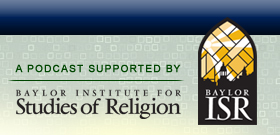

|
David Mislin on Embracing Religious Pluralism  Date: November 15th, 2015
 In the late 19th and early 20th centuries, the United States experienced a tremendous amount of economic, demographic, and cultural change that became reflected in a number of new religious movements and trends. Prof. David Mislin, assistant professor in the Intellectual Heritage Program at Temple University, discusses how this era gave rise to new conceptualizations of religious pluralism on the part of mainline Protestants and how this, in turn, shaped the way we think about religious diversity in our contemporary era. All of this is based upon his new book Saving Faith: Making Religious Pluralism an American Value at the Dawn of the Secular Age. We begin with a little ex post facto revelation on the part of Prof. Mislin. When asked about how he came to study American religious history, he recounts his childhood years growing up as the son of a Congregationalist preacher, his mom. While avoiding the typical life of a preacher’s kid (being dragged to every Sunday School event), he nonetheless developed a deep interest in how people of different faiths interacted with one another, a tendency that was augmented during his high school days. He realized after he had published his book how much of an impact that his youth had on his thinking. We then move back in time to talk about the religious changes that were occurring at the “dawn of the secular age” (circa 1875-1925). Rev. Lyman Abbott of Plymouth Church in Brooklyn is highlighted as a leading figure in embracing religious pluralism. Our discussion here covers the scientific, economic, demographic, and cultural changes that were taking place during the late 19th century and why David sees this era as a “gilded age crisis of faith.” He then lays out three distinct responses that many mainline clergy had to this changing landscape, including the New Theology movement, promotion of the Social Gospel, and a new conceptualization of religious pluralism. It is the latter that we then turn our focus to. Along the way, we also discuss some of the other religious dynamics occurring at the time, including the rise of Christian fundamentalism and how this might be related to changes within mainline Protestantism. Prof. Mislin explains what this new embrace of religious pluralism was all about. Based upon a growing Christian skepticism of the time, he notes how ministers began arguing that all faiths are good, but that this did not necessarily mean all faiths were equal — an interesting intellectual tension. Our conversation covers the theological trend to see revelation as a progressive movement throughout history, with each new generation being able to discover new tendencies in God’s plan. The reduction of transportation costs and the missionary experiences of many clergy in places such as the Middle East, India, and East Asia also furthered an interest in non-Christian faiths such as Buddhism, Hinduism, and Islam. David reviews some of the colorful characters of the time who became strong advocates for reaching out to other faiths. We also talk about how this ecumenical outreach manifested itself in the creation of comparative religion programs at American universities, the Goodwill Movement reaching out to Jews, and an attempt to (re-)unify Protestants and Catholics in one church. The latter was almost exclusively a Protestant effort that fell flat, but was nonetheless indicative of the thinking of the day. Our podcast concludes with Prof. Mislin’s reflections on how the ideas advance between 1875 and 1925 impacted religious trends during the remainder of that 20th century, and how — thinking about a Bill & Ted’s Excellent Adventure — Lyman Abbot would view today’s religious and cultural landscape. Recorded: November 11, 2015. RELATED LINKS David Mislin’s bio at the Intellectual Heritage Program at Temple University. Saving Faith: making Religious Pluralism an American Value at the Dawn of the Secular Age, by David Mislin. RELATED PODCASTS John Inazu on the Four Freedoms, Religious Liberty, and Assembly. Matthew Sutton on Aimee Semple McPherson. Barry Hankins on Jesus, Gins, and the Culture Wars.
4 Responses to “David Mislin on Embracing Religious Pluralism”Leave a Reply to Richard2 |
 Search The Podcast
To search the podcast, type a term and click the Search button.
  Browse Podcast Categories
Select a category below to browse the podcast:
   |















“…the “dawn of the secular age” (circa 1875-9125).”
Looks like the secular age will be a long one. Secularists should be pleased.
Oops, that would be a long waiting period.
Since corrected.
Thanks!
[…] David Mislin on Embracing Religious Pluralism. […]
[…] David Mislin on Embracing Religious Pluralism. […]